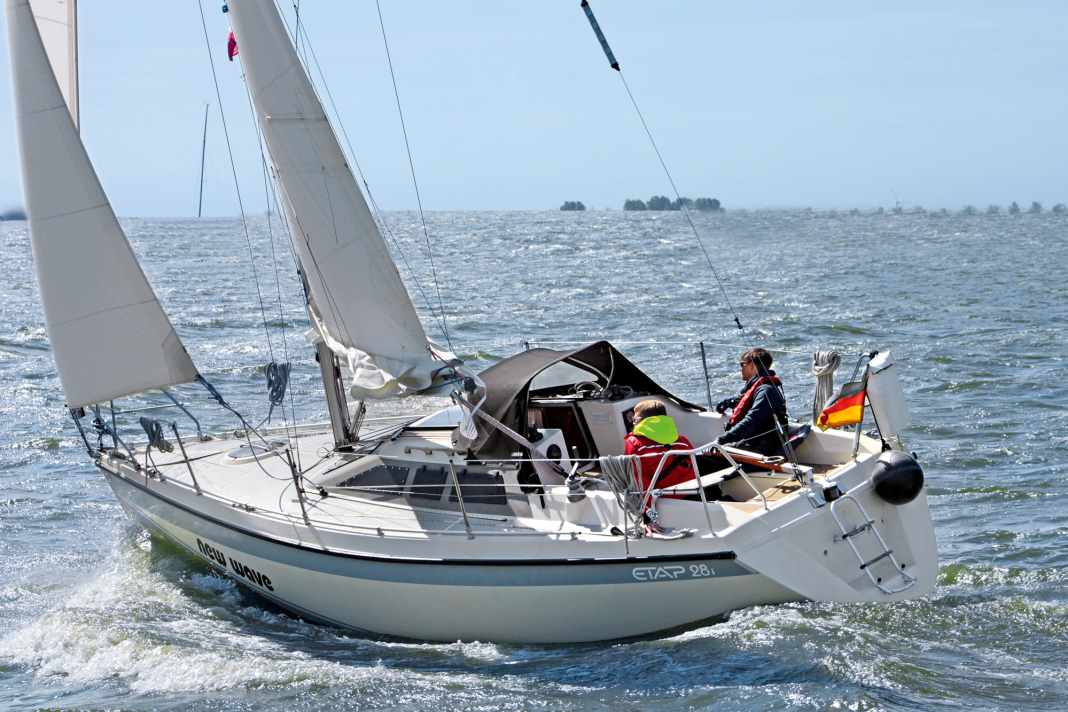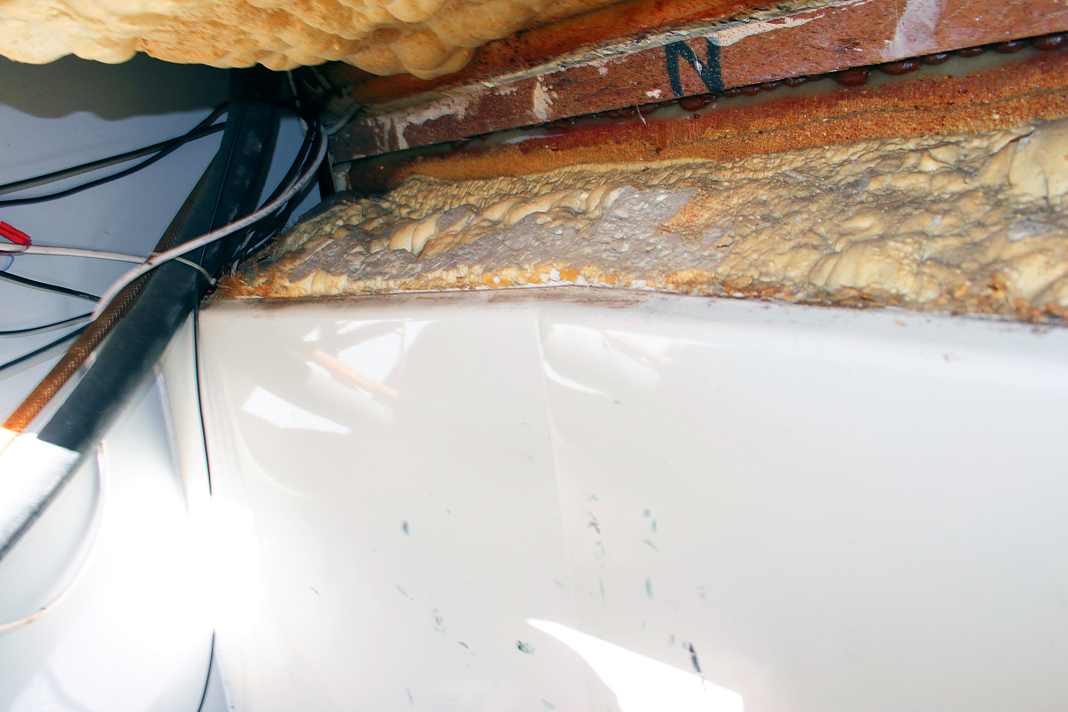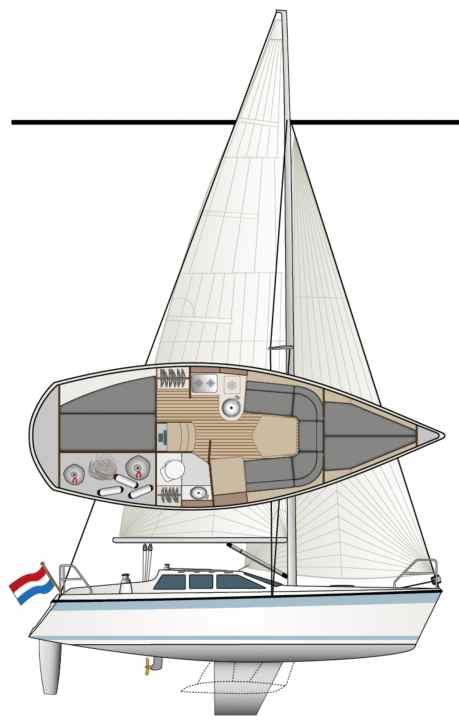





Sometimes there is a seven in front of the decimal point on the log. A powerful bow wave proves that the ship wants to go faster, but can't quite do it. The hull speed has long been reached, as the wind is blowing a good 20 knots from the north.
A wave lifts the stern, a little drop at the right moment, and off you go on a speedy ride, which is slowed down after a few seconds of euphoria by the next wall of water - only to start again straight away. Sailing fun in the sunshine on the IJsselmeer, which on the test day produced short, but still respectable waves. Two reefs in the main and the jib are enough to propel the Etap 28i. The boat is well balanced on a beam reach, the rudder pressure is moderate, the course stability is not breathtaking, but sufficient. The genoa can stay in the back box today. It brings a lot of life to the boat in light winds.
More used boats in the test:
Thanks to the 7/8 rig, even when reefed a pull on the backstay tensioner helps to release pressure in gusts and trim the headsail flatter. And while the waves are still quite impressive even in the cover off Medemblik, the 8.6 metre long yacht churns through them quite undisturbed. The cockpit behind the cabin superstructure offers protection, and the high freeboard allows the crew to perceive what is happening as if they were on a much larger ship. And somehow, the idea of unsinkability is still very much in the back of the mind, which contributes to the feeling of safety.
This impossibility of sinking is a unique selling point of the Belgian shipyard from Malle near Antwerp. Together with a pretty decent build quality, especially for the GRP parts, and a high level of vertical integration, the yachts still have a large fan base.
Tragic decline
Still - even though the shipyard has no longer existed at the site since 2009. Following a takeover by the Dehler shipyard in Freienohl, which was almost insolvent itself at the time, the lights soon went out at Etap. Moulds and equipment were moved to Poland, but series production was never resumed there. The current owners of the brand have not yet managed to breathe new life into the ships with the duck. This is a shame, because the models, which started at 21 feet, were an asset to the market. The end was heralded when Etap also wanted to build larger, more profitable ships, such as the 46 DS.
However, the double-shell and therefore foamable production meant that a separate, expensive mould would have been required for each interior design variant. However, the quantities did not allow for this. So there was often only one version - not enough in the upper segment.
Similarly, the way Etap built yachts was too costly to be able to sustain itself in the yield-hungry charter market. The end of the company, which at its best employed 110 people and was part of a lamp manufacturer that still exists today, was sealed. Moreover, the Belgians never gave up batch production: The boats were built for stock and then sold. From today's perspective, boatbuilding is different: first an order is placed, then the boat is built exactly to the customer's order. Thanks to the advance payments, this also reduces the liquidity risk for the shipyard.
Stable offer
The boats were very solidly built at the time, and today there is a wide range of second-hand boats available at a stable price. "If you buy well and take good care of it, you can sell your Etap for almost the same price after a few years. The year of construction hardly plays a role," says André Hochfeld from Yachthandel Hamburg, explaining the market situation. The company in the north-east of the Hanseatic city was an Etap dealer for Germany at the time and is still in business with used boats and spare parts today. "I estimate that 500 of the 28i were produced," says Hochfeld. She is a real small yacht.
It now has to prove this in the test. It goes upwind. A deep forefoot with a slightly sloping stem allows the Etap to pitch rather good-naturedly in the short waves. At the same time, it only leans slightly on its side. The hull is a full 3.13 metres wide, which corresponds to a length-to-width ratio of 2.75. The duck has obviously been well fattened.
Prominent tiller on the Etap 28i
The keel, which is only 1.15 metres deep, initially makes little contribution to stability when the boat is heeled slightly; this comes from the shape. "The tandem keel with its 90 centimetres was even better in the wind, which is why the 1.15 metre deep version was later removed from the range," says Hochfeld. The alternative version is 1.60 metres. But even with what is reportedly the least suitable upwind fin, the 28i proves to be a lively sailing boat. A little rudder pressure, right angles that the track draws on the iPad and a speed of just under six knots are perfectly acceptable.
In the cockpit, everything is where it needs to be for the small crew. The helmsman has both the foresheet and mainsheet, including the traveller, within easy reach. However, the tiller takes up a lot of space during manoeuvres. If there are four people in the cockpit, you need to be well organised. Even under engine power, the tiller requires constant attention; the Etap does not go straight ahead on its own. During manoeuvres, the stop on both sides is a nuisance, but it is essential as otherwise the rudder blade would hit the hull.
The 28i - where the "i" stands for innovation - followed on from the Etap 28, which is available for less than €10,000 in some cases, although it is a much older design without a double aft cabin and without a real wet room. Its successor is the 28s, which was designed by automotive designer Bertone. The yacht with the huge cockpit and the elliptical superstructure, when offered, is traded for over 55,000 euros.
Plenty of space below deck
The two newer models have a similar layout below deck. On the port side, there is a really large aft cabin in which two adults can sleep well. Inside, it is only a little low under the cockpit tub at just under 40 centimetres. To starboard there is room for a surprisingly spacious wet room. There is space for a toilet and washbasin and even a small oil locker.
The level of the diesel can be read from a piece of hose. The tank in the aft locker has an inspection hatch - exemplary. The highlight: a line runs from the forecastle boxes into the wet cell. If it is secured in the curry clamp there, the locker lids can no longer be opened from the outside.
Although the galley is small, it offers cupboard space, a sink, a refrigerator and a cooker. A spirit stove was installed there on the test boat. However, there would also be space for a real cooker with oven, but then a gas system would have to be installed. Further forward in the saloon, which offers just under 1.80 metres of headroom, there is a cosy U-shaped seating area. It can also be used for sleeping if necessary. The large panoramic windows above provide light and the aft ones on the sides also provide air. The table can be adjusted sideways.
There is another berth open to the saloon. However, it is quite narrow and two adults have to like each other to be able to sleep there comfortably. It is separated from the saloon by a curtain. The sleeping area at the front is the ideal solution for smaller children. The 28i is therefore a great family boat: solidly built, sailing with little heeling due to the large beam and with the safety aspect of unsinkability for the back of the head. In addition, the few weak points are quite manageable.
Used boat prices for the Etap 28i depend on the condition, not the year of construction
There is little talk of osmosis in newer Etaps. The Belgians had a very analytical approach to boat building. NPG resins were used early on. In addition, closed moulds were used as often as possible, which resulted in excellent surfaces, as can be seen on the locker lids, for example.
The TBS deck covering is also available as a prefabricated spare part. The rudder bearings, which will naturally fail over time, are also still available and can be replaced by the owner with a little skill. The Seldén rig raises no questions. If the standing rigging is replaced regularly, it should not cause any problems. The age of the saildrive sleeve needs to be clarified at the time of purchase. It must be replaced in accordance with the manufacturer's specifications.
As used boat prices are not dependent on the year of construction, but rather on the condition, it is worth looking for a well-maintained example. After a few years of good maintenance, the boat should be able to be sold again with only a small loss in value - if desired. This means you can enjoy inexpensive sailing fun, provided that no major repairs are necessary, for example to the engine. In any case, the Etap 28i is versatile and solid enough for many carefree years.
Pay attention to this






Etap yachts are considered robust, and rightly so. The weak points of second-hand yachts are manageable if the foam is in order
The Etap 28i in detail

Technical data of the Etap 28i
- Designer: Harlé/Mortain
- Torso length: 8,58 m
- Width: 3,13 m
- Draught/alternative: 0,90/1,15/1,60 m
- Weight: 2,8 t
- Ballast: 820/895 kg
Hull and deck construction
Double-shell, solid GRP with foam filling between the shells. Hand lay-up method
Prices
- Base price ex shipyard 1988: approx. 58,000 €
- Used price: 23.000-35.000 €
YACHT review of the Etap 28i
Solid, unsinkable family yacht with good performance potential. Family-friendly due to separate aft cabin
Design and concept
- + Unsinkable
- + bathing platform
- - Low headroom
Sailing performance and trim
- + Good sailing characteristics
- + Many trimming options
Equipment and technology
- + Baking crate lid lock
- + Oil kit bag
- - Single-circuit cooled motors
The article first appeared in YACHT 17/2017 and has been updated for the online version.

